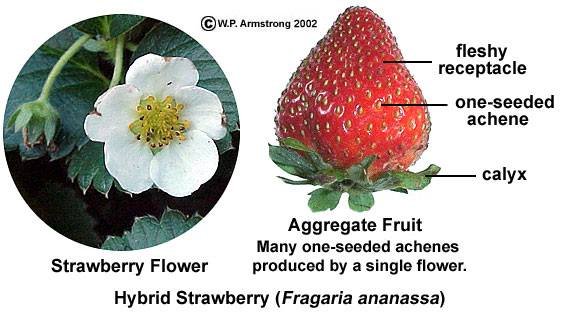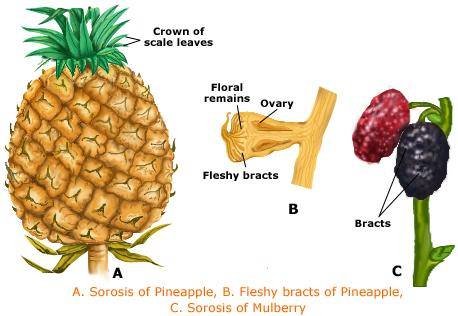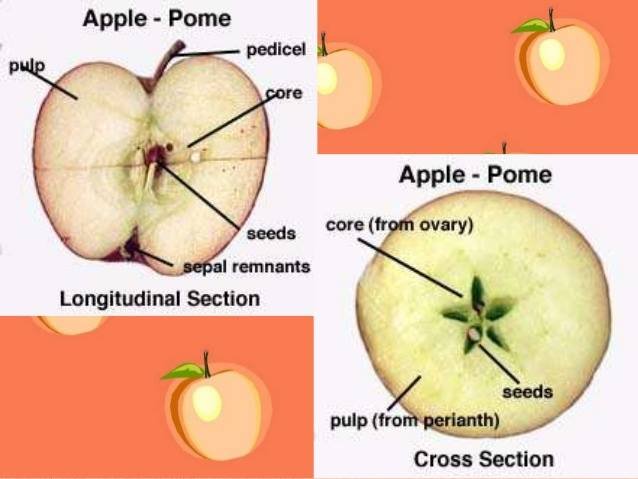The Fruit
The stimulation of fertilization causes series of changes in the wall of ovary.The result of these changes is the formation of fruit from ovary and seed from ovule.The ripened ovary is called fruit while thw ripened ovule is known as seed.
The wall of fruit is called pericarp.
True fruit:-
When the fruit is ripened alone then it is known as true fruit.
False fruit:
Some time other part of flower like thalmus developed into fruit and called as false fruit or pseudocarp.
Types of fruit
There are main three types of fruit:- simple, aggregate and composite.
Simple fruit
The ovary of simple fruit is from a single flower in which the gynoecium is monocarpellary and polycarpellary os syncarpous.The simple fruit may be dry or succulent.
A. Achenial
These are dry and one seeded fruit which is indehiscent.When the fruit ripened the wall do not rupture.The wall of fruit rupture when it fall to the ground due to the embryo development then the testa and fruit wall ruptured.
There are further types of achenial fruit which are given below
(a) .Achene
(b) .Caropsis
(c) .Nut
(d) .Samara
(e) .Cypsela
B. Capsular Fruit
The fruit consists of many seeds and dehiscent is called capsular fruit.The term Dehiscent means that when the fruit ripened their pericarp rupture to allow seed to escape.
The types of capsular fruit are given as following:-
(a) . Legume
(b) . Follicle
(c) . Siliqua
(d) . Silicula
(e) .Capsule
C). Schizocarpic fruit
They are dry and many seeded fruits.If these one seeded part is indehiscent, they are called as mericarp and if they are dehiscent ,they are known as cocci.
The chief types of schizocarpic fruits are given as following:
i. Lomentum:-These are legume or pod modified by the formation of false septum and constriction between the seeds.
ii. Double samara:-They are derived from bicarpellary superior ovary
iii. Cremocarp:-This is developed from bicarpellary, syncarpous inferior, bilocular ovary containing a single suspended ovule.When it ripen, it split longitudinally between the loculi into seeded mericarp.
iv. Carcerulus:-This is developed from bi or monocarpellary , syncarpous superior ovary.
v. Regma:-This is derived from polycarpellary, syncarpous with a superior multilocular ovary, having singlenseed in each locule.
Simple succulent Fruits
The wall of ovary made from three layers.When the fruit ripe the layers become hard while the one of these layer become fleshy and juicy. In dry fruit there is no difference between these three layers and whole wall form the pericarp while in succulent fruits the layers retain their distinction into epicarp, mesocarp and endocarp.
There are three types of succulent fruits.
- Berries:- The berries are indehiscent, usually many seeded fleshy and juicy in nature.As in bringil, tomato, orange and pomegranate.
- Drupes Fruits:- They are derived from monocarpellary.They also show three layers like epicarp, mesocarp and endocarp. The endocarp forms hard shell which enclose the seed.
- Pome:- This is the fruit of apple and pear etc.They are derived from syncarpous and bilocular ovary.The outer portion of the fruit is edible while the seeds are enclosed in the center of fruit.The term epicarp, mesocarp and endocarp not applicable to this type of fruits.
Aggregate Fruit

An aggregate fruit is the collection of simple fruits which developed from an Appocarpous pistil of single flower.The collection of simple fruits is now known as Etaerio.
There are following types; - Etaerio of Achenes: This is found in buttercup, strawberry and lotus.
- Etaerio of Follicle: This is found in calatropis.
- Etaerio of Drupes:This is found in raspberry and black berry.
- Etaerio of Berries: Simple apple is included in this type of fruit.
Composite fruit

The fruit which formed from whole inflorescence is known as composite fruit.These have further following types:- - Syconus: This composite fruits are formed from hollow, pear shaped form of capitulum called as hypanthodium.For example peepal.
- Sorosis: This fruit is formed from female spike, e.g mulberry and pineapple.
- Strobilus:Tese are developed from cone like female inflorescence.As in hop.
